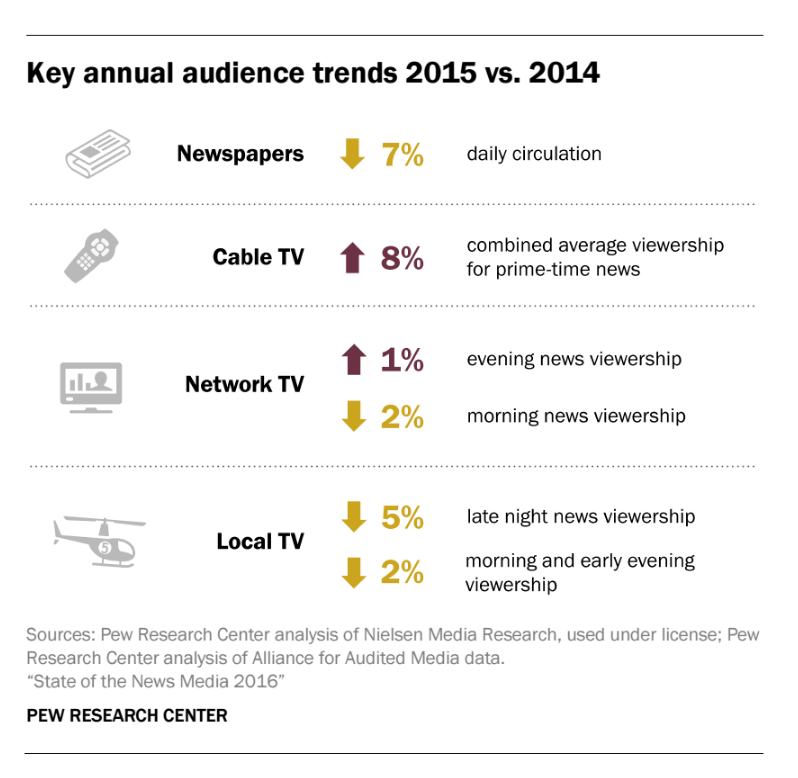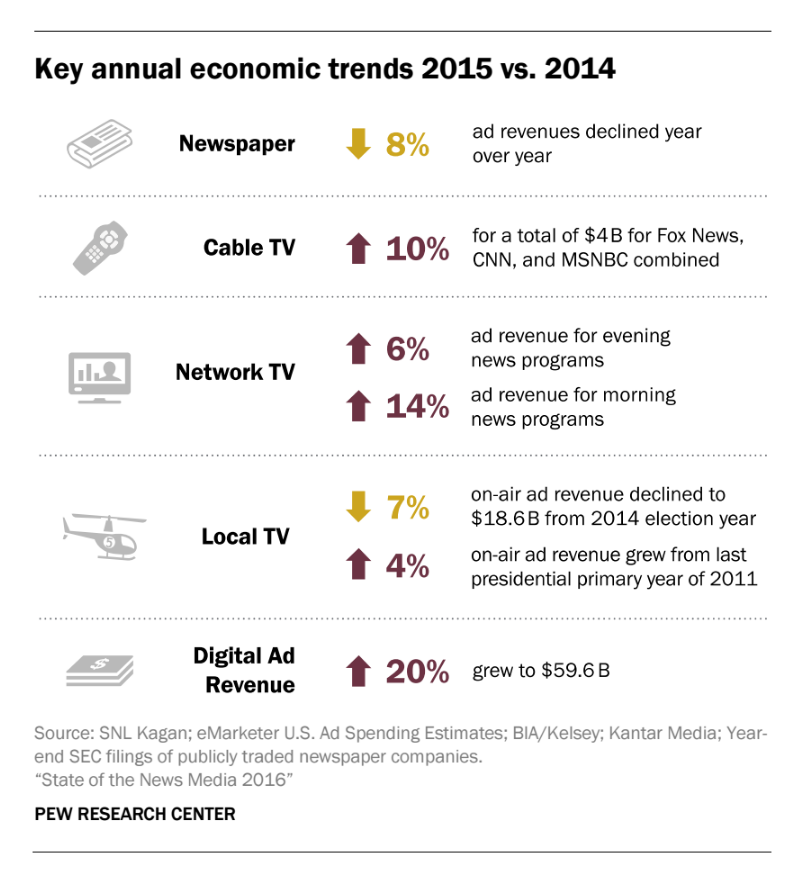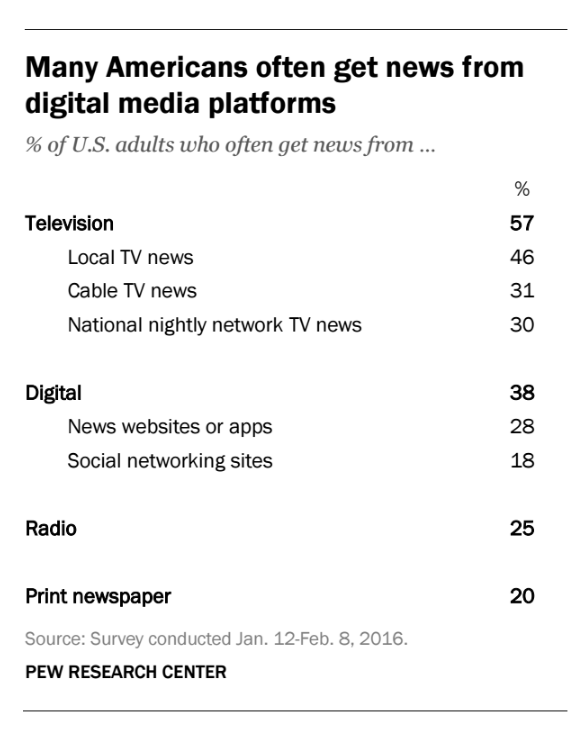The 13th annual Pew Research State of the News Media Report documents another year of alarming declines for newspapers — the worst since the 2008-2009 recession.
Other sectors did much better, with revenues actually growing robustly both for cable channels (up 10 percent) and network news (up 6 percent for evening shows and 14 percent for mornings).
Cobbling together newspaper data that is less current and available than it once was, Pew estimates that the industry lost 7 percent of daily circulation in 2015 and 8 percent of ad revenues.
More up-to-date surveys of readership provide further cause for discouragement. Pew research in January 2016 found nearly everyone is following news of the presidential race. But only 5 percent said print newspaper coverage in the last week was their “most helpful” source (3 percent local papers and 2 percent national) — by far the lowest among available channels.

(Source: Pew Research Center)
A broader study Pew did with the Knight Foundation around that same time found that 20 percent of adults said that they often get news from print newspapers. That was still slightly more than the 18 percent often getting news from social media sites.
But newspapers lagged behind local TV news (46 percent), cable TV news (31), network evening news (30), news websites (28) and radio (25) as a frequent source. When Pew began these studies in 2004, newspapers had a wide lead over the internet and radio and were close to even with TV.
Even as it matures, the digital sector is trickier to measure collectively — especially given what co-author and Pew’s director of journalism research Amy Mitchell calls “co-dependence” between sectors. While big platform companies hog 65 percent of digital ad revenues, they depend on traditional news organizations for content. Those organizations, in turn, rely on Google and Facebook and newer platforms like Snapchat and Instagram for distribution.
The overview to the report summarizes the state-of-play this way:
It has been evident for several years that the financial realities of the web are not friendly to news entities, whether legacy or digital only. There is money being made on the web, just not by news organizations. Total digital ad spending grew another 20% in 2015 to about $60 billion, a higher growth rate than in 2013 and 2014. But journalism organizations have not been the primary beneficiaries. In fact, compared with a year ago, even more of the digital ad revenue pie — 65% — is swallowed up by just five tech companies. None of these are journalism organizations, though several — including Facebook, Google, Yahoo and Twitter — integrate news into their offerings. And while much of this concentration began when ad spending was mainly occurring on desktops platforms, it quickly took root in the rapidly growing mobile realm as well.
That uneasy balance will likely remain in force for some years, Mitchell told me in a phone interview, and the report offers this forecast:
Original reporting and writing are the two industry roles largely left to news organizations (though there are a handful that are using machines to produce news). None of the others carry much worth without these two key elements — so these roles are in some ways critical to tech companies. But it is also true — and some nonprofits have found this in their struggle to get audiences — that well-reported news stories are also not worth much without the power of strong distribution and curation channels. What is less clear is how the tug and pull between tech and journalism companies will evolve to support each other as necessary parts of the whole, and what this rebuilt industry will ultimately mean for the public’s ability to stay informed.
The report notes that the latest census of full-time editorial employment at newspapers found 32,900 jobs at the end of 2014, a 10 percent decline in one year and nearly a 40 percent decrease since 2004. With further job cuts having taken place but yet to be counted, newspapers will soon have fewer news employees than local broadcast (27,600 and holding steady by most recent count).

(Source: Pew Research Center)
How many of those lost reporting and editing jobs have been supplanted by growth in the digital sector? A 2014 Pew study found roughly 5,000 digital news jobs. “We want to revisit and update that,” Mitchell told me, “but we were not to able to do it in time for this report.”
As in recent years, the report is organized around data-rich sector-by-sector “fact sheets.” Among findings that jumped out to me:
- For local broadcasting, 2015 was an off year politically and advertising was down 7 percent. But that was nearly covered by a $1.4 billion growth in the retransmission fees cable systems pay stations. And political ads will roar back this year.
- Cable networks recorded an audience increase of about 8 percent and the 10 percent revenue growth largely because of interest in the presidential primaries in the second half of 2015. Look no further for an explanation of wall-to-wall political coverage.
- The network evening audience, far off its peak, now seems to be stabilizing. Sunday morning talk show audiences increased.
- As widely reported, mobile now accounts for the majority of visits on both legacy websites and digital-only sites. But time per visit is higher on desktop, and that gap is widening.
- Big, high-profile digital sites benefit from continued and substantial venture capital investment. But as operations, most are not especially profitable:
(The) robust digital advertising market has not lifted most news publishers — even digitally native ones — out of a place of financial uncertainty, as competition for those ad dollars and the rise of consumer ad-blocking pose challenges to their digital business models…. For the many local and regional digital publishers that dot the U.S., a combination of ad sales, philanthropy, individual giving and other revenue streams pay the bills.
- Video advertising grew 46 percent to $7.7 billion in 2015. The banner ad category remains larger, though video is gaining share.
- Podcasting continues to grow, though still only 21 percent of adults listen in a given month and 64 percent never do so.
- Sirius radio now has 29 million subscribers.
- In ethnic media, Hispanic media is growing, although there was some shakeout in 2015 as outlets close. The audience for African-American media continues to fall.
- NPR ran a positive balance for the first time in several years, and local station revenue has risen moderately.
- News magazines are negotiating their own digital transition with advertising revenues down about 5 percent each of the last two years.

(Screenshot, Pew Research Center)
So does all this amount to more or less news for the public? “In terms of access points,” Mitchell said, that clearly is growing. “But it is more work (to find the news) and sift through it.”
Editor’s note: Edmonds co-authored the newspaper chapter of report from 2004 though 2013.







